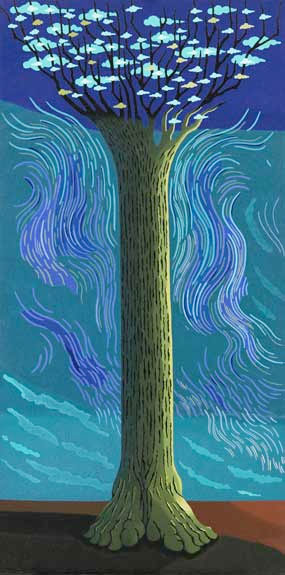Pillar and Man
From James B. Jordan’s fascinating Thoughts on Jachin and Boaz [1]
“The Tabernacle and Temple were not only pictures of the kingdom of God. They were also pictures of the human person (John 2:21). We have noted that the High Priest had a chain around his neck, and pomegranates and bells encircling the ephod. Without any difficulty we can see the 1-cubit collar of the pillar as a neckband, the lily as the head, and the bronze shaft as the trunk. The size and proportions are roughly equivalent to those of a 5’ man.
This suggestion is strengthened by the fact that legs and feet are symbolized as bronze in Scripture (Rev. 1:15; 2:18; 10:1). In Daniel 10:6, both arms and legs are bronze. Ezekiel’s man with the measuring rod was bronze-like in total appearance (Ezk. 40:3). It may be noteworthy that Goliath is described as armored from head to food in bronze (1 Sam. 17:5-6), since Goliath is surely an archetypical strong man in the Bible, and the pillars speak of strength (Boaz = Strength). Could the pillars in part be pictures of God’s people as true giants, true Goliaths? It was David, of the house of Boaz, who defeated Goliath and showed himself the true giant in the situation.In terms of design, I stated above that it is simplest to see the lily as the head, the collar as the neck, and the shaft as the trunk. In terms of analogies to the High Priest, though the proportions will be different, it might be more accurate to say that the lily corresponds to the turban and golden plate, the collar to the ephod as a whole, and the shaft to his bare feet. (The Tabernacle/Temple was holy ground, and shoes were not worn.) Thus, the ephod as a whole corresponded to the collar and the Holy Place. We note that the ephod had a ring of alternating pomegranates and bells at the bottom, a breastpiece of jewels in the middle, and a chain of gold around the top. The Holy Place was also decorated with chains and jewels, and with palm trees and gourds, visually equivalent to pomegranates (1 Kings 6:18; 2 Chron. 3:5-6) .As we have seen, the collar corresponds to this.
The fact that the golden plate on the High Priest’s turban is called a crown (Ex. 29:6) certainly indicates that this was the highest point of his attire, and creates an immediate association with the Holy of Holies and the pillar lily. Beyond this, we have to point out that the pouch in the center of the ephod also corresponded to the Ark in the Holy of Holies, being in the center, its shape square, and its contents two tablets of stone. We see from this that the Ark and the Holy of Holies speak of both the head and the heart. The lily of love at the top of the pillar also speaks of both head (topmost, leadership) and heart (love).
Since the pillars represent persons, we ask if they represent just any Israelite citizen, or someone in particular? The answer is a simple yes. The pillars do represent every Godly citizen, but they also represent two persons in particular, as we should expect…
[Get the paper for this bit!]
…Since the imagery on the pillars was that of love and marriage, we see that true leaders love their people, and regard themselves as married to them, bound to them, and obligated to them.”
* * * * *
“…We must also take note of the fact that many scholars today believe that Jachin and Boaz may have functioned as incense altars. This is what the bowl on top was supposedly for. This suggestion easily squares with the facts and meaning of the pillars, as we shall see. It does leave unexplained how the priests got up the pillars to burn the incense. It also does not explain how often and when such burnings took place.
To see the rationale for this suggestion, we have to bring together several things. First, the shape of the pillars, 23 x 4 x 4, is that of a column, but a fat one. It is similar to the shape of the incense altar in the Temple, which was 2 x I x 1, and contrasts with the bronze altar of the courtyard, which was much wider than it was tall (Tabernacle, 3 x 5 x 5; Temple, 10 x 20 x 20).
Second, God manifested Himself to Israel as a pillar of cloud and fire. This is occasionally thought to be two pillars, like the legs of God, but almost certainly it was one pillar. The vision of God in Ezekiel 1 is that of a cloud having fire within. At night the fire would be visible, while in the daytime the cloud would be seen. At the same time, each of these bronze pillars might represent God’s presence, since they were to reveal the interior of the Temple to the people. God’s glory was enthroned there, in the cloud. Perhaps these pillars were also cloudy on occasion. As Albright wrote, “At night the burning wicks of the gullah [bowl] and in the day the smoking incense might well be associated” with the pillar of cloud and fire.
Third, in that the pillars signified holy mountains, it is perhaps significant to note that Mount Sinai was covered in smoke when God was there (Ex. 19:18).”
_____________________________________________
[1] Occasional paper, available from www.biblicalhorizons.com See also Landing Gear.
Art: Firmament by Seve, Galerie d’Art.


























